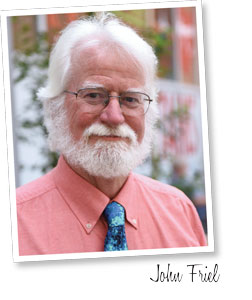1/1/2018
O Canada!
John Friel

I recently had the good fortune to be invited to speak about ornamental grasses at Landscape Alberta in Calgary. It was my second appearance at this yearly event and the weather has been predictably bleak both times: mid-November is, after all, winter in Canada. This time, it was six degrees two mornings in a row—Fahrenheit, not Celsius. It never warmed up to merely freezing during my stay.
As always when abroad, I was a bit abashed at how much the locals know about my country and how little I—and probably you—know about theirs. Can you name their Prime Minister? I had to Google it. You’d be hard-pressed to find a Canuck who couldn’t ID our President and they probably know more than two words of our anthem.
That’s natural given that the USA is among the world’s political and socioeconomic 800-pound gorillas, but it also bespeaks a certain smugness and insularity here. We’re like New Yorkers who consider all other cities irrelevant.
The disconnect is regrettable, but understandable, where vast geographical separations and language barriers apply. But on a shared landmass, where one can literally have a foot in each country? Far to the east of Calgary, performers onstage in Stanstead, Quebec, regale audiences seated in Derby Line, Vermont—in the same building. But I digress.
Fortunately for the green industry, the Great White North and the U.S. have much in common besides a border—like what we can put in our borders. Zone hardiness is always a concern when one ventures far from one’s accustomed orbit and numerous genera didn’t make my PowerPoint cut. But even in close calls, I got positive responses from audience members who grow, say, calamagrostis successfully. It’s Canada’s unofficial official grass.
That’s important to those of us who speak about hardy plants and/or write catalogs. We cite hardiness zones conservatively, especially with newer introductions, lest we oversell a given taxon’s cold tolerance. We smile at Tony Avent, Plant Delights Nursery, whose optimistic mantra goes, “I consider every plant hardy until I’ve killed it myself three times,” but duty calls us to hedge our bets. Gardeners, garden writers and growers are slow to forgive if plants sold as hardy to Zone 4 fail to answer spring’s wake-up call in 6.
Getting it right can be tricky. As a denizen of Zone 6b to 7, I have to take a lot on faith. Even reasonable conclusions based on parentage are suspect: If Zone 3 daddy’s stamen begat viable seed via Zone 4 mama’s pistil, junior should be hardy at least to Zone 4, right? Um ... sure, if you’re 100% positive those were the only possible inputs. Just know that even in controlled breeding programs, some things elude control. Tiny pollinators sneak through like midnight border-crossers. Recessive traits bob to the top of the gene pool. Wind happens.
With all that in mind, it was encouraging to be assured that Bouteloua gracilis lives up to its rating. This assurance came from a resident of Winnipeg, Manitoba, an unforgiving Zone 3a, where “blue grama grass” thrives.
Grasses appear to be a growing Canadian presence. An exhibitor at the accompanying Green Industry Show told me that just five years ago she rarely saw grasses in gardens, but they’re now common. My talk drew a goodly crowd despite two other concurrent sessions.
I’d love to return to Calgary. It’s a vibrant, thriving city, flush with capital from tourism, and gas and oil drilling. But I’ll wait until the weather’s more reasonable, when there’s more green than white and the grasses are blooming. GP
John Friel is marketing manager for Emerald Coast Growers and a freelance writer.